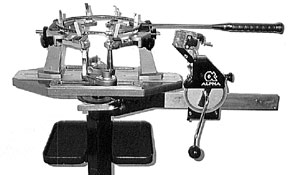|
|

String Your Own Racket?
By Steve Crandall
Vice President, Sales & Marketing
Ashaway Racket Strings
 There's a mystique about people who string their own racquets. They seem so dedicated to badminton, so technically astute, so...into it. But for every player who does his own stringing, how many own stringing machines that are gathering dust in the attic? Stringing machines are like diets; they're full of good intentions and potential benefits, but they rarely fulfill their promises. There's a mystique about people who string their own racquets. They seem so dedicated to badminton, so technically astute, so...into it. But for every player who does his own stringing, how many own stringing machines that are gathering dust in the attic? Stringing machines are like diets; they're full of good intentions and potential benefits, but they rarely fulfill their promises.
Should you do your own stringing? Let's look at the pros and cons. The most obvious benefit of home stringing is economy. Most strings cost $3 to $8 per set, while professional stringing usually costs $15-20. For anyone who needs to restring frequently-and that includes chronic string breakers and other power players, "badminton families," and tournament players-the savings can add up quickly.
Convenience is another benefit. The do-it-yourself stringer can get a string job whenever he or she wants it, without having to drive anywhere or wait for anyone. For the tournament player, this means no more anxious waits at the stringer's booth, for stringing jobs performed under pressure with your second or third favorite string.
By stringing your own, you take control over your equipment. You purchase the string, select the tension, and experiment whenever you want. You gain satisfaction from doing it yourself and becoming expert in another aspect of your sport. With practice, every string job will be consistent, which may improve your game. Finally, there's the potential to bring in a few extra dollars by stringing for friends and club members.
There are also lots of reasons not to become an amateur stringer. Start with the cost of the equipment. Professional-quality, floor-model machines may cost $1,000. On the other hand, some consumer-quality tabletop machines that use drop-weights to tension the string cost as little as $100-$300.
I asked Don Hightower, Associate Director of the United States Racquet Stringers Association (USRSA) about these inexpensive machines, and he urged players to proceed with caution.
"Especially for beginning stringers, it can take a surprising amount of time to string a racquet on a drop-weight machine," he said. "These machines are not very user-friendly, and may offer less convenience than taking the racquet to a pro."
Even if the machine is a good one, some players simply don't have the time to spare, so home stringing becomes a burden, not a convenience. For many, it's easier to leave the racquet at the club's pro shop, and pick it up the next time they play. Few amateur stringers develop the expertise pros can provide.
Most home stringers work in an information vacuum, and do not know how to fine-tune their equipment for the best results. With practice, home stringers can obtain good results on their own racquets, but may be at a loss to find the recommended string pattern and tension when confronted with an unfamiliar racquet. It seems unfair to charge your friends for work that may be of questionable quality.
Don Hightower recommends that players who need expert stringing or advice should seek out a USRSA Certified Stringer or Certified Racquet Technician (CRT). "A pro may be able to solve a breakage or playability problem through string selection or racquet tuning," he said. "Going the home-stringing route is not always the best way to obtain better quality and economy."
If you need help finding a certified pro in your area, call the USRSA at: (619) 481-3545.
This article previously appeared in USA Badminton.
|